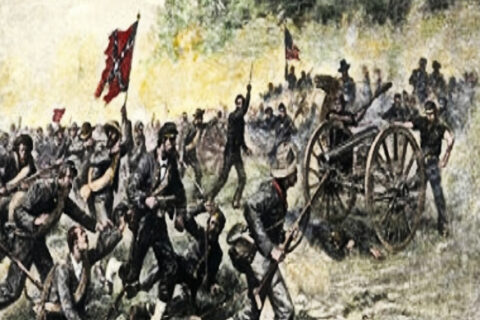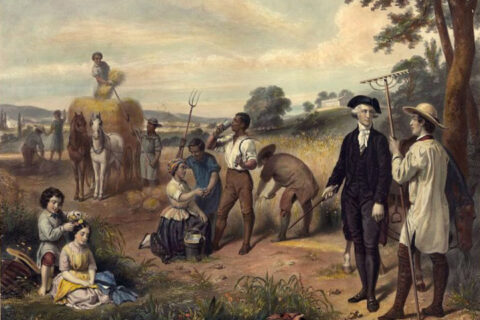After the great War Between the States, our people faced a desolate land of burned universities, destroyed crops and homes, with manpower depleted and crippled, and even the mule, which was required to work the land, was so scarce that whole communities shared one animal to make the spring plowing. There were no government handouts, Marshall Plan aid, no coddling to make sure that our people would not suffer; instead the South was set upon by the vulturous carpetbagger and federal troops, all loyal Southerners were denied the vote at point of bayonet, so that the infamous, illegal 14th Amendment might be passed. There was no money, no food, and no hope of either. But our grandfathers bent their knee only in church and bowed their head only to God.
Governor George Wallace
Alabama, The Heart of Dixie, the first Capital of the Confederacy, has long been a pivotal, though overlooked, state within Dixieland. Much like the Peach State to its east, Alabama stood far from unanimous in its vote for secession. With Unionism encompassing the entire northern third of the state, Alabama faced a physical war against both the Federal Army and its lawless Appalachian populace. Despite the staunch undercurrent of anti-secessionist sentiment, also called Toryism and Unionism, the state would develop into arguably one of the most culturally pro-Southern entities within its section as the years progressed, entrenching this sentiment more deeply into its state iconography which still even exists today. These quasi-anarchic subregions of Unionists would later produce the most infamous anti-integrationist actors and actions of the 20th Century, George Wallace and Asa Carter being examples. The macabre Klan activity of the 1950s and 1960s and violent resistance to integration served as an expose of the underlying feelings of animosity, recalcitrance, and bitterness, all of which find roots dating back to nearly a century prior. This essay will examine the economic, political, and social events and effects of Reconstruction in Alabama.
Economically, the state suffered on par with what could have been expected. The War itself placed scores of Whites in indigence, and Reconstruction did little to nothing to mitigate this. While Alabama did miraculously escape the campaigns of wanton destruction at the behest of the Union Army, it did still receive its own collateral damage. Poor crop yields during 1865 and 1866, the Panic of 1873, a depression throughout the late 19th Century, the destruction of anything of worth in Selma during the War, and the federal munition stockpile’s explosion in Mobile would provide far too numerous hurdles for the state to overcome in a short time.
Yet, the greatest impediment to Alabama’s recovery after the War was the Radical control of government. Upon their seizure of power, Radicals began drastically increasing the taxes on the average White citizen, forcing the latter into selling their lands and being unable to send their children to school. Poverty would continue to escalate under such conditions and the Black Belt county Whites suffered the most. Fortunately, superfluous government expenditures, though present, would not exceed that of the other Deep South states, despite Alabama’s steep Radical bend during the time. However, this did not negate the simple fact property had been grievously devalued during the War and only continued to plummet, and the state’s debt climbed under Radical rule. The Republican Radicals left a financial footprint on the state so large it would take generations to pay off and recover from.
The first few years of political Reconstruction carried over fairly mildly, often leaving Alabamians to recover of their own volition. From roughly 1865 to 1868, the state government had little effect on the lives of the average citizens it ruled over. The provisional governors and military commanders during the time were of little note but did prefer to encroach on the lives of everyday citizens as little as possible. The military commander over the state Freedman’s Bureau, Wager Swayne, generally did his best to work alongside Governor Robert Patton, a moderate. However, this was all for naught as the Radical controlled Congress would ultimately pass the Reconstruction Acts of 1867 and remove both from their positions.
Upon seizing control, the Republicans immediately set about forming a state constitutional convention. With Whites demoralized and Negroes controlling much of the state demographically as well as the successful organization of the Union Leagues, the convention consisted almost entirely of Republican carpetbaggers, scalawags, and Negroes, the former and the latter being fervent Radicals more often than not. The constitution submitted for ratification by Alabamans would be one of the more asininely Radical ones among the former Confederacy, including Louisiana, Texas, Mississippi, and South Carolina. What truly stood out about this particular vote was that Alabama became the only Southern state to not ratify this newly proposed constitution under the guidelines set by the Reconstruction Acts. Despite this, Congress would readmit Alabama to the Union and declared the rejected constitution the law of the state anyway, infuriating many and submitting the state to vast White disfranchisement, in addition to the disfranchisement which had already taken place.
The three governors which presided over Radical rule gravitated towards the middle, adopting moderate views when possible and one being a Democrat. The first true Reconstruction governor, Democrat-turned-Republican William Hugh Smith, was generally incompetent. Moderate in political philosophy and lacking in good political tact or craft, he had no allies, being too lenient towards the handful of existing Democrats and not going far enough to aid the dominant Radical faction. However, he turned a blind eye to the plundering of the Black Belt counties and did little to stop the blatant abuse of power and dishonorable acts of Republicans, yet did little to combat Ku Klux activity. In all, Smith was a fence-sitter. He found little success in any of the few endeavors he undertook and served a single, two-year term from 1868-1870.
His successor was surprisingly a Democrat. Incompetent much like the man before him, Governor Robert B. Lindsay marked the beginning of the end of the Radical Republicans. With Radicals controlling the State Senate but the Democrats barely controlling the House following the election of 1870, the next two years amounted to little more than political gridlock. Many ignoble Democrats had invested in the crooked issuances of state bonds and made it impossible for Lindsay to correct the state debt and spending issues. Additionally, the Democrats were comprised of young and inexperienced men, lacking the pedigree and superlative talent of the preceding generations.
The Democrats would not fare as well in the 1872 election, and after some accusations of fraud and some time of each side refusing to concede, the Radicals regained some control over the legislature. David P. Lewis was seated as governor but served only one two-year term. Effecting and accomplishing little, the Democrats would officially “Redeem” Alabama in the following elections.
By the election of 1874, Democrats were poised to succeed. Running on a platform of White solidarity, the Democratic Party was able to pull away a majority of the Unionist Whites in the northern counties away from the Republican Party. Though Republican and loyalist by nature, North Alabama Whites despised Negroes with an immeasurable fervor. By the election, two major railroads had been constructed from the Black Belt to the isolated mountains and allowed those Whites exposure to Negro rule. George Smith Houston won the election with unforeseen lack of violence. The campaign was hard fought but legitimately did not reach the levels of violent outbreaks seen in the past. Governing with stringent financial control and frugality, his tenure addressed the debt problem and put the state’s affairs back in order. The Democratic Party controlled Alabama politics for a century afterwards, and Negroes lost interest in politics by 1900.
The social ramifications of wartime and loss were dire. With the aforementioned economic factors in play, Radical seizure of government only served to demoralize Whites further. The northern counties suffered the most during the War. Constant fighting between opposing forces decimated much of the local infrastructure and livelihoods. Adding further to the wanton destruction, the Loyalists and Unionists in the northern counties were often justifiably referred to, even in antebellum days, as “White trash.” The most reprehensible lot of Unionists in all of the Confederacy, these men would lead Federal raiding parties against planters in the Tennessee River Valley and formed roving gangs of marauders that settled scores and terrorized towns. The region was one of the primary hotspots of army desertion, both Confederate and Union, and would remain highly isolated and resentful towards its more affluent neighbors to the south until railroads finally pierced the mountains.
The Black Belt counties would later receive the brunt of the misery during Reconstruction. Amicable planters who developed naturally intimate relations with Negroes for the most part, they became subject to the whims of the newly freed Negro and his political aspirations, helpless to guide the Negro due to the constant intervention of the meddlesome Union Leagues, Freedman’s Bureau, and Abolitionist Northern Missionaries. Subjugated to harsh taxes and demographically outnumbered, Whites often sold their land and lives without political representation and power. Of all demographics of Whites, these were the most desperate to end Reconstruction by 1874. Existing in desperation, former planters and various rural Whites flocked to the cities hoping for work. Thus, they left behind once prosperous plantations to be divided up for Negroes’ use, ultimately becoming decrepit and decaying relics of the Old South as time continued its unrelenting march.
Though not enduring the worst of the War, Alabama truly stood out as a place abounding with secret orders and fraternal societies. Ku Klux Klan activity permeated throughout the northern counties, the northern sections of the Black Belt, and the western counties. The Louisiana originated Knights of the White Camelia also established a strong presence in the lower Black Belt and the southwestern counties. Neither held much ground or influence in the southeastern counties.
The Ku Klux groups were content to simply intimidate with outlandish and frightful displays as Confederate ghosts and otherworldly beings to keep Negroes in line in 1867. However, carpetbaggers were not so easily fooled and the Blacks grew used to the shenanigans. Warnings and punishments would become the norm by spring of 1868, and the northern Black Belt sections were rife with Klan activity. Federal crackdowns would later ensue.
The Knights of the White Camelia found more success in their respectable and restrained approach to dealing with carpetbaggers. Rarely utilizing violence, they found other means to ostracize or run out of state agitators from the southern counties. Like the Klan, they had disappeared by 1871. All other manner of militia, vigilante, or regulator groups existed at the time, but their names have been lost to history. Their reasons for existence began as social regulators to replace the lack of law enforcement in rural counties, only turning towards a political motive in the late 1860’s.
The story of Alabama’s Reconstruction drew to a close without much of a display of grandeur. Whites dedicated themselves wholly to the defeat of the Republican Party but refrained from ruthless confrontation in the latter years of the period. The economic, political, and social conditions of Reconstruction would leave the populace demoralized and indigent, the once illustrious Black Belt plundered and decrepit, the White population replacing their amicable intimacy with Negroes to that of a fermenting malice once seen only in the isolated northern sections, and a series of unfortunate economic scenarios stunting and stagnating recovery for generations. Yet, Alabama endured. It became one of the most overtly pro-Southern states within Dixie and even to this day features the Southern Cross as part of its state seal. However, an optimistic outlook does not hide the dark history which precedes it. With modern developments and a Civil Rights Movement set upon it, Alabama, never truly recovered from its fall from grace. With the future appearing grim for its cultural and political wellbeing, there exists a few holdouts in its more isolated counties, unfortunately hindered by the neglect of a hostile contemporary world and economy, a tidal wave of modern day carpetbaggers, and a reputation for macabre racial hostility.
“The White people of the South are the greatest minority in this nation. They deserve consideration and understanding instead of the persecution of twisted propaganda.” –Strom Thurmond






Thank you, as always, for the history lesson. This is the most vital thing we can do right now and you are a Saint for doing this.
Now we must write it all down, make a curriculum written solely by us, unalterable by anyone else or governmental agency. Then we MUST educate our own children.
I have never left the South and have no desire to do so, yet a couple of days ago was the first time I had ever heard of Wallace’s last stand at the school house doors. A Yankee shared the video on GAB to support me as I argued with a Southerner who did not believe me when I said I was forced into a school that was a nightmare ran by a Federal Judge. She did not believe me and a Yankee backed me up, let that sink in. I really still don’t know much about Wallace or anything else to do with our history. I just knew who I was as a Southerner, I really did not need an explanation from a school that I knew to be evil, even if I did not know why it was.
As I watched this video of Wallace’s at the school, trying to spare me from the fate they had planned for me, all I could think was “How do our people not have their own history and curriculum after watching what they were doing to us in real time?” I could not grasp it, how on earth from the moment it was known that they were taking our schools and forcing us into their hellholes did we not instantly create our own curriculum and ensure that every Southern child had access to it? How? How is it possible that in the year 2021 there is still no such thing as a Southern curriculum, by us, for us? How has everything that has happened not been documented and made teachable by us in real time, as it happened and then made teachable? It makes me want to scream to think of how much has been lost, how much time was wasted, what we were forced to endure, in ignorance. ITS OWN OWN FAULT.
All of the gaslighting and psychological torture we endured could have been nullified, all of the decades of defending RINOs and being “judeo” Christian, of supporting Israel and the Party of Lincoln, all of the absolute waste of time talking in circles arguing with teachers. My childhood and that of my friends and family could have been spared with a letter, a letter! Just giving me the understanding of what had passed and what was happening, who I was and why I was being tortured and lied about. A letter as a child could have saved me decades, I would have never coped thinking there were places like Liberty University, when in fact it is a Yankee cuckservite training center. How many decades were wasted supporting cuckservitism and then the process of realizing that it was not going to work and the people pushing it did not want it to work, when I could have just read Dabney and known. We have known it for over a hundred years, yet here I am throwing decades of my life in the trash on something I should have known about in middle school. It makes me sick.
I endured school thinking it would be okay, the internet had been invented, I could go learn there. But I was wrong, there is no Southern curriculum, how is that possible? How is that not the first thing we ever did and how the hell does it still not exist when the internet does not require Yankee publishing houses or banks? I could work at Burger King and afford to host documents online.
It really dawned on me watching my nephew take his classes online, before a black kid murdered him for no reason, that we fought for homeschooling for so long and all we did was bring our enemies lies into our living room and fill their pockets.
We must develop a framework where you and everyone else can go and leave their knowledge of everything that has happened, for every single day, in every single place since this occupation began. A place to pool our knowledge, only us, Southerners. Then all of that must be codified and then made teachable. Then it must remain intact and expanded on in real time from now on. Only we can add to it and only we can teach it, to our children, all of them, no children left behind anymore.
How does it not exist? I want to scream until I collapse, what could anyone have possibly been doing that was more important than this?